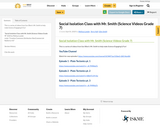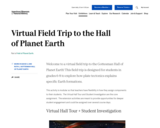
This is a series of videos from Sun West's Mr. Smith to help make Science Engaging & Fun!
- Subject:
- Science
- Material Type:
- Activity/Lab
- Date Added:
- 04/08/2020

This is a series of videos from Sun West's Mr. Smith to help make Science Engaging & Fun!

Students learn about one method used in environmental site assessments. They practice soil sampling by creating soil cores, studying soil profiles and characterizing soil profiles in borehole logs. They use their analysis to make predictions about what is going on in the soil and what it might mean to an engineer developing the area.

Students learn the basics about soil, including its formation, characteristics and importance. They are also introduced to soil profiles and how engineers conduct site investigations to learn about soil quality for development, contamination transport, and assessing the general environmental health of an area.

Students are given the following engineering challenge: "The invasion has taken place and we need to find a new home. To ensure your survival beyond Earth's occupation you must design a shelter that can be built on another planet." Then students research the characteristics of a planet of their choosing. They design shelter that enables them to survive on a new planet, and explain it in words to the rest of the class. This is a great activity to add to a unit on the solar system.

This lesson introduces students to the space environment. It covers the major differences between the environment on Earth and that of outer space and the engineering challenges that arise because of these discrepancies. In order to prepare students for the upcoming lessons on the human body, this lesson challenges them to think about how their bodies would change and adapt in the unique environment of space.

This hands-on project is an impactful way to show students how truly immense our solar system is! You get to decide if you want your model to show scale planet sizes or the scale distances between planets. You can combine a planet-size model of one scale with a distance model of another scale. But if you want size and distance to be the same scale, you’ll need to spread your model across at least half a mile!
Specific directions on how to calculate size/distance scales are included.

Ideas for schools, municipalities, organizations and individual citizens for celebrating Earth Day.

Students learn about tornadoes - their basic characteristics, damage and occurrence. Students are introduced to the ways that engineers consider strong winds, specifically tornadoes, in their design of structures. Also, students learn how tornadoes are rated, and learn some basics of tornado safety.

Students learn about tornadoes, the damage they cause, and how to rate tornadoes. Specifically, students investigate the Enhanced Fujita Damage Scale of tornado intensity, and use it to complete a mock engineering analysis of damage caused by a tornado. Additional consideration is given to tornado warning systems and how these systems can be improved to be safer. Lastly, students learn basic tornado safety procedures.

Students will analyze data of tornadoes throughout the United States. They will create a bar graph of the number of tornadoes for the top ten states in the country and then calculate the median and the mode of the data.

Students apply their knowledge about mountains and rocks to transportation engineering, with the task of developing a model mountain tunnel that simulates the principles behind real-life engineering design. Student teams design and create model tunnels through a clay mountain, working within design constraints and testing for success; the tunnels must meet specific design requirements and withstand a certain load.

This resource effectively illustrates the ways in which animals are important to the health and future of the planet. Four lessons demonstrate how human activities, including those related to climate change can result in habitat fragmentation and threaten the viability of entire ecosystems. The resource includes a teacher's guide, background information, student activity pages, videos and extension ideas for individual, group and community action.
Activity One: What’s your View? (1 x 60 minutes)
Teachers set up a 'four corners' activity in which students read a variety of statements concerning animal welfare and decide if they agree or disagree. The class then discusses as a group the importance of animals in sustaining healthy ecosystems and the value of their relationships with humans.
Activity Two: Video (1 x 60 minutes)
Students watch a video called “Why Animals Matter” and complete a short quiz to check their understanding of key concepts raised in the video. A discussion follows on what can be done to make the world a better place for animals. Suggestions for extension activities are included.
Activity Three: Eco-investigation (3 x 60 minutes)
Students go outside to study local biodiversity. Working in groups, they select a 2m square sample site near the school yard and determine the variety of plant, fungi and animal life found. The inventory includes the abiotic characteristics of soil, rocks, water sources as well as any evidence of human disturbance. Students are also asked to take notice of the resources that species need to survive (food, water, cover and space) and how humans have impacted these resources.
Activity Four: Understanding Habitat (3 X 60 minutes)
After a discussion on the inter-dependency of the four core elements of a habitat, the class is invited to brainstorm ideas as to the causes and effects of habitat fragmentation and the importance of wildlife corridors. Students then review a newspaper article describing how habitat fragmentation due to road construction in parts of India has impacted elephant populations. Four groups of students take on the role of stakeholders in a wildlife corridor project for the benefit of these elephants. Groups must develop a persuasive statement to reflect their point of view. Peer evaluation and class discussion follow.
An extension activity suggests students research the habitat requirements of a wild animal, how these needs can be threatened by human disturbance and what solutions should be considered.

Students learn about the phases of the moon by acting them out. In 30 minutes, they will act out one complete, 30-day, moon cycle.
*Materials required:
-pencil or wooden skewer (one per student)
-white styrofoam ball, 5 centimetres or larger (one per student)
-light source, such as a lamp (shade removed) with a bright, clear, incandescent bulb (100 watts or higher)

The University of Saskatchewan Science Outreach team has created videos and lesson activities that align with Saskatchewan Science 7 curriculum outcomes.

Geared towards students in grade 6-8, this virtual field trip from the American Museum of Natural History explores how plate tectonics explains specific Earth formations.
This field trip includes a teachers guide, student worksheets and extension activities.

Students learn about the mechanics of a lunar eclipse.
Students will use the Danjon Scale of Lunar Eclipse Brightness to assign an “L” value at three points during an eclipse. After the eclipse, students compare and justify their evaluations of the eclipse.

This lesson from NASA explains how the Earth's tilt causes the seasons. There are also links to related resources on the webpage.

During this activity, students learn how oil is formed and where in the Earth we find it. Students take a core sample to look for oil in a model of the Earth. They analyze their sample and make an informed decision as to whether or not they should "drill for oil" in a specific location.

Students will learn the difference between global, prevailing and local winds. In this activity, students will make a wind vane out of paper, a straw and a soda bottle and use it to measure wind direction over time. Finally, they will analyze their data to draw conclusions about the prevailing winds in their area.

Students learn about wind energy by making a pinwheel to model a wind turbine. Just like engineers, they decide where and how their turbine works best by testing it in different areas of the playground.